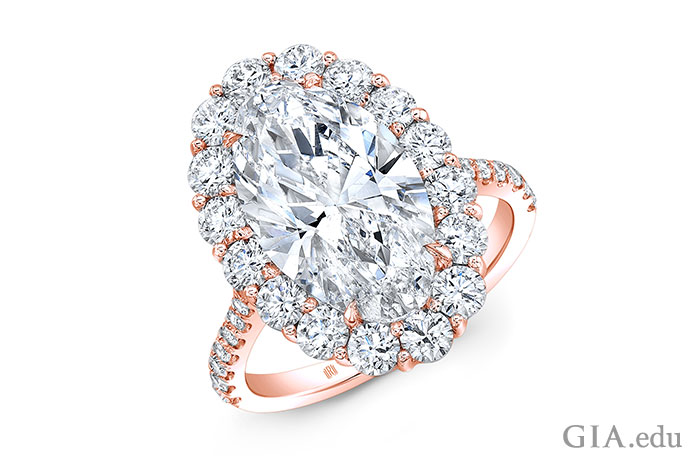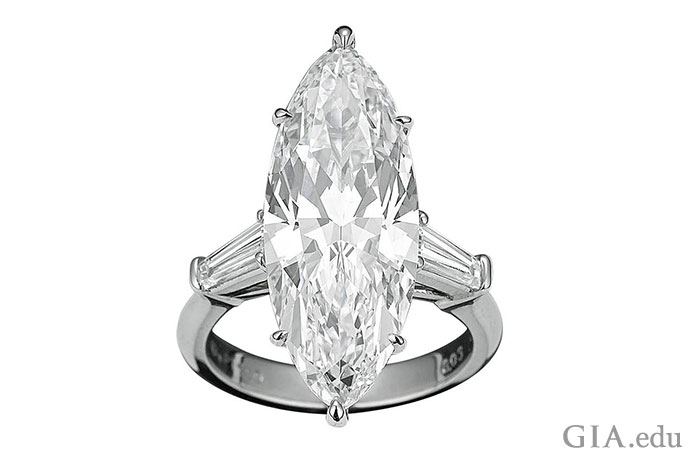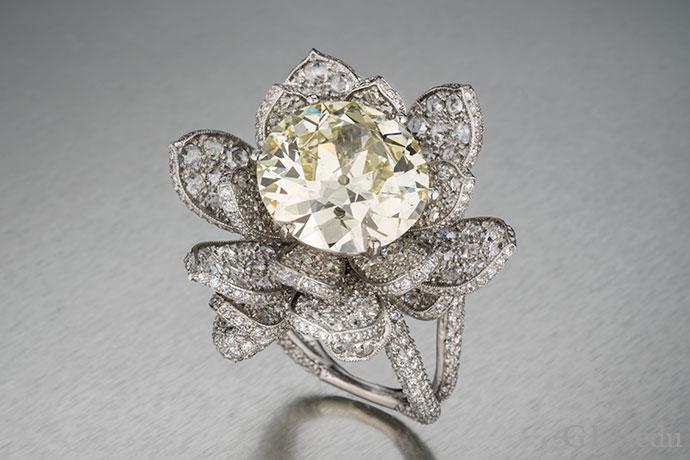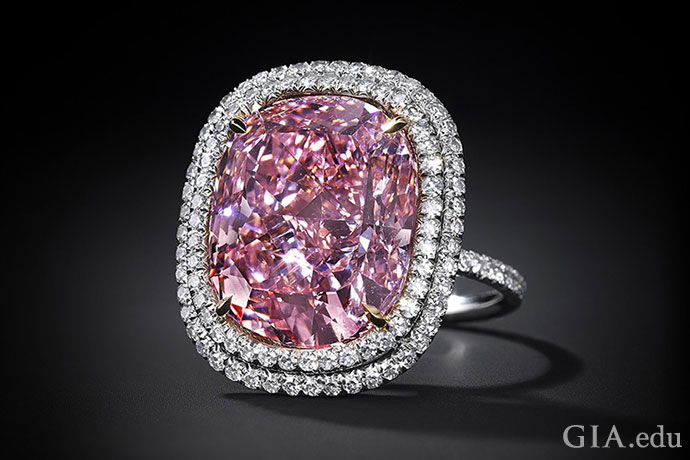Selecting the right metal for your engagement ring setting is just as important as selecting the right diamond. The metal will not only define the ring’s style, but it can also play a big role in your diamond’s color appearance. Here’s how to choose wisely.

A gold engagement ring allows the solitaire diamond to be the star of the show. Diamond melee along the ring’s shank play a supporting role, adding even more sparkle to the overall effect. Courtesy: Stuller Inc.
Gold, platinum and silver are the metals most often used in jewelry. Their allure, workability and durability make gold and platinum excellent choices for an engagement ring. For many people, choosing an engagement ring setting starts with a color and style preference. Some prefer the warmth of yellow gold or rose gold engagement rings; others opt for the coolness and classicism of white metals such as platinum or white gold for their engagement rings. Yet few people consider the effect that engagement ring’s metal color has on the most important feature of an engagement ring – the center stone, which is often a diamond.

An 18K rose gold band brings warmth to this 5.31 carat (ct) oval diamond. Courtesy: Rahaminov Diamonds
The importance of diamond color and reflection
When choosing an engagement ring setting in white gold, rose gold, yellow gold, platinum or silver, consider these important things:
Your diamond’s color. Although many people think of gem-quality diamonds as colorless, truly colorless diamonds are actually very rare. Most diamonds used in jewelry and diamond engagement rings are nearly colorless with hints of yellow, brown or gray. In picking an engagement ring in yellow gold, white gold or other metal for your ring setting, you’ll need to know where your diamond is on the GIA D-to-Z Color Scale.
The fact that diamonds are highly reflective. The many facets of a standard round brilliant diamond and other diamond shapes act like tiny mirrors reflecting their surroundings, including the color of the band and the prongs holding the gem.
Knowing this, you can use the color of the metal in your engagement ring to highlight your diamond’s color or create a more harmonious appearance.

An 18K gold band complements the hint of yellow in this 1.20 ct N color emerald cut diamond for a very harmonious look. Courtesy: 1stdibs.com
Once you’ve settled on whether you want your engagement ring design to highlight the main diamond or create a sense of harmony between the setting and the center stone, you’ll have many options to choose from. Remember, your jeweler is your best resource. She or he will understand the subtle nuances of diamond color and can make the best metal color recommendations to achieve the look you’re going for. Also, the best way to see a metal’s effect on diamond color appearance is to see the diamond and the engagement ring setting in person. In the meantime, though, here are some tried and true ideas to get you thinking.
Metals for diamonds graded D through J
All things being equal for diamonds on the D-to-Z scale, the less color the stone has the more valuable it is. Diamonds graded D-E-F on the GIA color scale are considered colorless, and a white metal—platinum or white-gold engagement ring setting is the ideal choice to emphasize their beauty. Diamonds graded G through J are in the near-colorless range, with an almost imperceptible hint of yellow. They, too, are good candidates for a platinum or white gold ring setting.
If you choose another color of metal or opt for a two-tone ring to create contrast, the prongs that hold the diamond should be a white metal like white gold or platinum. Yellow gold prongs could impart some yellow color to the diamond, making your colorless or near-colorless stone look like it has a different color grade.

A platinum band heightens the icy beauty of this 8.03 ct D color marquise diamond with 0.72 carats of colorless baguettes. Courtesy: 1stdibs.com

Like the white look, but want some contrast? This diamond ring features white diamond melee in an 18K rose gold halo, which adds visual richness to the design. Courtesy: PE Jay Creations
Metals for diamonds graded M through Z
A diamond with a color grade of M or lower will likely have a noticeable yellow tint. A yellow gold band will accentuate the yellow in the diamond; a white band might make the diamond appear more colorless. Diamonds with a color grade of K or L are in something of a middle zone; you can use either yellow gold or white metal bands such as platinum or white gold, depending on the effect you want for your engagement ring setting.

The diamond center stone in this ring is a K color. A gold band brings out the hint of yellow, giving the diamond a softer appearance. Courtesy: TrueFacet.com

A fanciful platinum setting with 5.05 carats of white diamond melee provides a pleasing contrast with the 11.04 ct yellowish diamond center stone. Photo: Robert Weldon/GIA. Courtesy: MUNNU The Gem Palace
Picking metals for fancy-color diamonds
Diamonds that fall outside the D-to-Z color range are called “fancy colors.” Selecting the right metal to accentuate these unique stones is key to delivering the radiance and allure of each engagement ring. Naturally occurring colors include blue, brown, pink, yellow and green. These diamonds are evaluated less for brilliance or fire and more for color intensity. Depending on the hue, tone and saturation of the color, the GIA Colored Diamond Color Grading System assigns colored diamonds one of these color grades: Faint, Very Light, Light, Fancy Light, Fancy, Fancy Intense, Fancy Vivid, Fancy Dark and Fancy Deep. Generally, Fancy Vivid and Fancy Deep command the highest prices.
Metals for brown diamonds
Brown diamonds were once deemed unsuitable for jewelry. Then marketers in the 1980s gave them tantalizing names like champagne, cognac and chocolate, and brown diamonds developed their own niche.
Like yellowish diamonds, brown diamonds can be placed on a white gold or platinum engagement ring setting to highlight their color, or they can be placed in a yellow gold or rose gold engagement ring setting to complement their color. Even the metal used for prongs can either contrast or complement the diamond in the center.

A 0.38 ct brown diamond pops because it is set in an 18K white gold band and surrounded by a double halo of 0.39 carats of white diamond melee. White prongs accentuate the look. Courtesy: 1stdibs.com

Neil Lane designed this ring for actress, model and Paralympic medalist Amy Purdy. A brown cushion cut diamond is the center stone. A yellow gold band creates a soft backdrop, while platinum prongs and white diamond side stones provide an arresting contrast. Courtesy: Neil Lane
Metals for yellow diamonds
Yellow diamonds were relatively rare until the discovery in the late 1860s of quantities of what today would be considered fancy yellows at several locations in South Africa. They are now found around the world. The presence of nitrogen gives them their color.
A platinum or white gold engagement ring can highlight the color of a yellow diamond, while a yellow gold ring will harmonize with the color of the yellow diamond.

A double halo of 0.94 carats of white diamonds is the frosty backdrop for a 1.02 ct yellow diamond. Courtesy: 1stdibs.com

The combination of a 7.02 ct fancy yellow heart shaped diamond, 1.08 carats of yellow diamonds in the halo and along the shank and an 18K yellow gold band creates an enchanting engagement ring setting. Courtesy: Norman Silverman
Metals for pink diamonds
Pink diamonds are exceedingly rare. Historically, they have been found in Brazil’s alluvial workings and in Indian and African mines. Since the late 1980s, the Argyle mine in Australia has been the most important source of pink diamonds, but even here they are quite rare. According to Rio Tinto Ltd., the owner of the mine, “more than 800 million carats of rough diamonds have been produced from the Argyle Diamond Mine. Total carats of pink rough: less than 1% of total production.” Not surprisingly, pink diamonds are extremely expensive.
Since the color of pink diamonds is so prized, it is rare to see them set in a yellow gold engagement ring setting. A pink diamond is the star, and the white metal band is used to highlight its color.

A white metal band and double halo of white diamonds form the elegant frame for this 16.08 ct Fancy Vivid pink diamond. The piece sold for more than $28.5 million at a Christie’s auction in November 2015. Courtesy: Christie’s
Metals for blue diamonds
Blue diamonds are also extraordinarily rare and very expensive. India is their historic source, and it is believed that the 45.52 ct Hope Diamond, the 31.06 ct Wittelsbach-Graff and other famous blue diamonds originated there. Today, the Premier mine in South Africa, which opened in 1903, is considered the most significant source of blue diamonds. Nevertheless, at the end of the 20th century blue diamonds accounted for less than 0.1% of diamonds found there.
Like pink diamonds, they are almost always set in a platinum, white gold or silver engagement ring setting that highlights their color.

A natural 5.98 ct Fancy Light blue diamond sits in a platinum band. Courtesy: Royal Ontario Museum, Toronto, Canada; Gift of Vincent Tovell. Certified by the Canadian Cultural Property Export Review Board under the terms of the Cultural Property Export and Import Act.
A beautiful engagement ring is the product of a number of choices that add up to a stunning creation. Knowing how to protect your diamond engagement ring setting is another important consideration.
